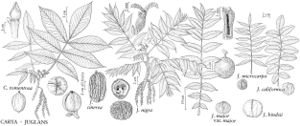Juglans
Sp. Pl. 2: 997. 175.
Gen. Pl. ed. 5, 431. 1754.
Shrubs or trees, 3-50 m. Bark light to dark gray or gray-brown, smooth or split into ridges or plates. Twigs purplish brown, terete, stout, sparsely to densely covered with glands and capitate-glandular hairs, sometimes also with scales or fasciculate hairs, early in season with multiradiate hairs; leaf-scars triangular or 3-lobed, large; pith chambered. Bud-scales valvate, densely hirsute. Leaves usually odd, sometimes even-pinnate; petiole and rachis with indument as twigs. Leaflets 5-25, sessile or subsessile, often aromatic, uniform in size or median leaflets largest, (2.5-) 4.3-15 (-17.5) × 0.8-6.5 cm; surfaces usually with nonglandular hairs (simple and/or fasciculate), glandular-hairs, sessile glands, and/or scales, sometimes glabrous. Staminate catkins solitary from 2d-year twigs, sessile; stamens 7-50 per flower, glabrous or pilose. Pistillate flowers solitary or in terminal racemes. Fruits nuts enclosed in husks, not compressed; husks thick, indehiscent; nuts tan, neither compressed nor angled, grooved, ridged, rugulose, or smooth; shells thick. Seeds sweet. x = 16.
Distribution
North America, Mexico, West Indies, Central America, South America, Eurasia
Discussion
Species 21 (6 in the flora).
Juglans is a very important source of edible nuts, dyes, and wood for cabinet work, furniture, and construction. Juglans regia Linnaeus, the walnut of commerce, is widely cultivated in California; it is easily distinguished from native species by its leaves with 5-11 broad, entire leaflets and nuts with thin rugulose shells, not grooved or ridged. Because of its sensitivity to native pathogens, J. regia is usually grown as stem-grafts on roots of native or hybrid walnuts (see discussion under J. hindsii). Occasional seedlings of J. regia have been reported from the vicinity of cultivated plants, but these seldom, if ever, live to maturity.
The growth form, bark, and fruit are important taxonomically in Juglans, but these usually are not available on herbarium specimens. As with many woody plants, the first one or two leaves of the season (i.e., the lowermost leaves on the twig) are sometimes atypical in structure, having broader, blunter leaflets. The fasciculate hairs on the veins normally have more rays than those on the blade. In addition to the types of hairs described below, small multiradiate hairs are found on the immature twigs, petioles, rachises, and midribs. They are usually gone when the leaf is fully expanded, but they may persist for a short time afterwards.
Selected References
None.
Lower Taxa
Key
| 1 | Fruits ellipsoid to ovoid or cylindric, surface of nut with ca. 8 high, narrow, longitudinal main ridges, with narrow, interrupted, longitudinal ridges or lamellae between main ridges; terminal buds 12–18 mm; distal edge of leaf scar straight, bordered by well-defined velvety ridge; white walnuts (Juglans sect. Trachyocaryon Dode ex Manning). | Juglans cinerea |
| 1 | Fruits globose, rarely ellipsoid, surface of nut smooth or longitudinally grooved; terminal buds 3–10 mm; distal edge of leaf scar notched, usually glabrous, sometimes velvety, never forming prominent velvety ridge; black walnuts (Juglans sect. Rhysocaryon Dode). | > 2 |
| 2 | Leaflets narrowly elliptic to lance-elliptic, apex rounded to acute; abaxial surface without tufts of hairs in vein axils; s California. | Juglans californica |
| 2 | Leaflets lanceolate to lance-ovate or narrowly triangular, apex acuminate (sometimes blunter on 1st leaf of season); abaxial surface with conspicuous tufts of fasciculate hairs in vein axils (except sometimes J. microcarpa); widespread but not in s California. | > 3 |
| 3 | Leaflet blades glabrous, hairs confined to major veins; nuts smooth or nearly so; California. | Juglans hindsii |
| 3 | Leaflet blades and veins with hairs, at least abaxially (hairs of blade sometimes becoming sparse late in season); nuts longitudinally grooved; widespread but not in California. | > 4 |
| 4 | Fruits 1.4–2.3 cm; nuts 1.1–1.7 cm; leaflets 0.8–1.1(–2.2) cm wide, with capitate-glandular hairs, nonglandular hairs limited to axils of proximal veins on abaxial surface; shrubs or trees 3–10 m. | Juglans microcarpa |
| 4 | Fruits 2–8 cm; nuts 1.8–4 cm; leaflets 1.5–5.5 cm wide, with both glandular and nonglandular hairs abaxially; trees 5–50 m. | > 5 |
| 5 | Fruits 2–3.5 cm, nuts longitudinally grooved, surface between grooves smooth; leaflets 9–15, adaxially with capitate-glandular hairs. | Juglans major |
| 5 | Fruits 3.5–8 cm, nuts longitudinally grooved, surface between grooves coarsely warty; leaflets (9–)15–19(–23), adaxially glabrous except for scattered hairs on midrib. | Juglans nigra |
